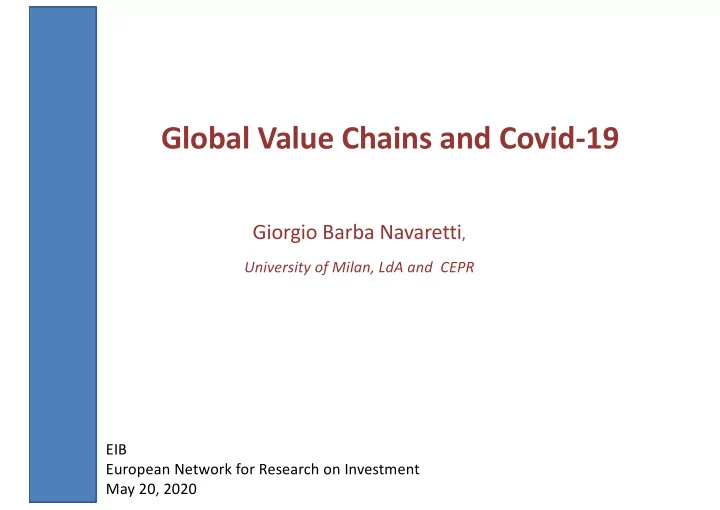

Global Value Chains and Covid-19 Giorgio Barba Navaretti , University of Milan, LdA and CEPR EIB European Network for Research on Investment May 20, 2020
Issues State of the art: Geography: where and what? Industries: which ones? • Firms’ perspective: the cost of distance • • Government’s perspective: transmission of shocks and re-shoring Government’s perspective: essential public goods and re-shoring • Reshoring how? • Heterogeneous countries • Heterogeneous firms • 2
A regional affair, but big players are very pervasive…. Especially China Source : Richard Baldwin, Rebecca Freeman, «Supply chain contagion waves: Thinking ahead on manufacturing ‘contagion and reinfection’ from the COVID concussion» , Voxeu.org, April 20202 elaboration of OCED Inter-Country Input Output Tables (available online at https://www.oecd.org/sti/ind/inter-country- input-output-tables.htm [3]). 3 Notes : The figures are the value-added share of direct and indirect inputs from the column nation in the row nation’s total manufacturing output.
Who does what? A pretty neat division of labour 4 Source: Pol Antras, «Conceptual Aspects of Global Value Chains», forthcoming, World Bank Economic Review
What industries? 5 Bonadio, Huo, Levchenko,Pandalai-Nayar 2020
Firms: the cost of distance Figure 2 Real time data on border crossing delays for 28 European nations (in hours) Source : Richard Baldwin, Rebecca Freeman, «Supply chain contagion waves: Thinking ahead on manufacturing ‘contagion and reinfection’ from the COVID concussion» , Voxeu.org, April 20202 6
Governments Transmission of shocks and re-shoring Bonadio, Huo, Levchenko,Pandalai-Nayar 2020 • Simulate a global lockdown as a contraction in labor supply (controlling for share of telework): – 31.5% drop in GDP=> 34:7% attributed to foreign transmission – 32.3% drop in GDP with re-nationalized supply chain: national economy affected by the virus anyway – It depends on the geographical spread and intensity of the shock 7
Governments Essential public goods • Can we clearly identify essential products? • Should they be considered public goods? • Does re-shoring them make sense? e.g. Masks – Þ Combine production of capital intensive meltblown fabric rolls with labour intensive assembling • Can re-shoring of essential products be market based? 8
Reshoring…. How? Heterogeneous countries • Uncertainty induced trade costs: same effect for all? • Asymmetries: large core countries vs small peripheral ones – Upward vs downward production stages – Intensity of GVCs… – Source of comparative advantage 9
Reshoring How? Back to firms: not just open market transactions Implications of a firm level perspective: Populist Firepower • Þ Distributional issues (superstar) Þ Uneven bargaining power in relationship specific transaction Resilience • Þ Relationship specific sunk costs 10 Source: Pol Antras, «Conceptual Aspects of Global Value Chains», forthcoming, World Bank Economic Review
Recommend
More recommend